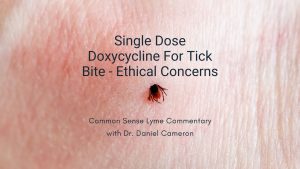Call for your appointment today 914-666-4665 | Mt. Kisco, New York

In a recently published paper, Nykytyuk and colleagues describe the case of a 13-year-old boy with Lyme arthritis, a common manifestation of Lyme disease, who developed a Herxheimer reaction when treated with doxycycline. [1]
“A 13-year-old boy was admitted to the regional hospital with complaints of left knee swelling, hip, ankle and cervical spine pain,” the authors write. The first signs of left knee arthritis began 6 months prior to his hospitalization.
The doctors assumed the boy suffered from post-traumatic arthritis and prescribed non-steroidal anti-inflammatory drugs (NSAIDs) which were only minimally effective.
Six months later, a rheumatologist diagnosed Lyme disease, in part, due to a reported tick bite which occurred 3 months before the onset of the left knee arthritis. The patient did not have a erythema migrans (EM) rash.
Laboratory tests were consistent with the diagnosis of Lyme arthritis and doctors prescribed doxycycline.
On day 7 of antibiotic treatment, the boy developed a Herxheimer reaction. “On the 7th day of doxycycline treatment the patient’s condition deteriorated: a low-grade fever occurred, and severe arthralgias with intense hip, ankle and cervical spine pain and myalgias developed,” the authors explain.
The boy also had elevated CRP (C-reactive protein) and ESR (erythrocyte sedimentation rate). Steroids were prescribed.
There was no evidence of neurologic involvement and a spinal tap was normal. Nevertheless, doctors prescribed 4 weeks of intravenous ceftriaxone which led to a resolution of the joint swelling and less arthralgias.
Herxheimer reactions in Lyme disease patients
Jarisch-Herxheimer reactions have been described in the literature with a combination of symptoms occurring including fever, severe polyarthralgias, and myalgias, according to the authors.
Other Jarisch-Herxheimer reactions have also been described. The list includes “chills, high temperature, hypotension, nonpruritic, nonpalpable rash, tachycardia, nausea, headache, strengthening of existing or occurrence of new symptoms of the underlying disease,” the authors write.
Some studies have found that Herxheimer reactions were milder in patients with Lyme disease when compared to other diseases, without organ dysfunction or need for hospitalization, Nykytyuk writes.
[bctt tweet=”The authors of a newly published case report call for increased awareness among physicians about the Herxheimer reaction. ” username=”DrDanielCameron”]
However, another case report by Haney et al., describes a more severe Herxheimer reaction in response to doxycycline in a patient with chronic Lyme disease. The patient developed “a low-grade fever, sore throat, sinus congestion, watery diarrhea, headache, stabbing pain in the upper back muscles, increased fasciculations and fatigue.” [2]
Physician education needed
The exact cause of Jarisch-Herxheimer reactions is still unknown. “At first, the role of an endotoxin in the development of JHR was suggested, but later experimental studies showed that spirochetes do not have biologically active endotoxins,” the authors explain.
Nykytyuk and colleagues emphasize the importance in educating physicians about the Herxheimer reaction, as there appears to be a “low awareness.” For example, “JHR is often mistaken for an allergic reaction.”
Editor’s note: It is not uncommon for Lyme disease patients to have flare-ups with or without antibiotics. Some patients refer to these reactions as “Herxing,” in the absence of a more descriptive word. The mechanisms of these reactions are uncertain. I typically avoid prescribing steroids to manage these reactions, as I do not want to suppress a patient’s immune system.
Related Articles:
Diagnosing Lyme arthritis of the hip in children
Successful treatment for Lyme arthritis after knee surgery
Will steroid injections help children with Lyme arthritis of the knee?
References:
- Nykytyuk S, Boyarchuk O, Klymnyuk S, Levenets S. The Jarisch-Herxheimer reaction associated with doxycycline in a patient with Lyme arthritis. Reumatologia. 2020;58(5):335-338. doi:10.5114/reum.2020.99143
- Haney C, Nahata MC. Unique expression of chronic Lyme disease and Jarisch-Herxheimer reaction to doxycycline therapy in a young adult. BMJ Case Rep 2016; 2016: bcr2013009433,
DOI: 10.1136/bcr-2013-009433.




I have had LYME since Oct 1984. It was originally diagnosed Epstein Barr Virus & Chronic Fatigue Syndrome. I have had a few major stressful events and I am bedridden again like in the early stages. It is severely active. I have never been treated with antibiotics for it. Ironically last week I had bilateral itching near both thumbs to the point of drawing blood. Now I am having severe joint pain in both thumbs which I was told years ago was arthritis. I am assuming I have significantly elevated EBV again as I feel as bad as I did 38 years ago.
Hi Paula, how are you doing now? Did you ever take antibiotics or seek herbal remedies?
Great article. I was unaware that a Herxheimer reaction was not caused by the release of toxins as the bacteria were killed. I also was not aware the cause remains unknown. An incredibly complex disease (s) that in Canada is not recognized at all. As a result little research is being done. Thanks
I was interested to read that the boy was given additional antibiotic treatment, which was effective. It is good news that the spinal tap was negative. I am glad to hear that you typically avoid prescribing steroids, to avoid suppressing the immune system.
Besides low awareness, I think sometimes doctors are nervous about prescribing antibiotics beyond 30 days, unless there is a positive spinal tap.
I think I read of a slightly longer course being recommended for lyme arthritis.
If you find an attached tick, going to urgent care to have it removed professionally is a safer option – they may also prescribe a prophylactic antibiotic starting the same day.
You can get Lyme more than once.
I think probiotic drinks can be helpful to maintain immunity – even between antibiotic doses, as well as once the course of antibiotics has ended.
Thoughts?
Only 2 of 27 patients with neurologic Lyme disease had an abnormal spinal tap according to Logigian and Steere 1990 NEJM. That means up to 9 out of 10 patients with neurologic Lyme have a negative spinal tap. I am not a fan of a single dose doxycycline for a tick bite. I encourage probiotics during and after antibiotic treatment.
Tiny ticks got all over me delivering mail to a house with an overgrown lawn in the country, only two got beneath my clothing and attached.. 2 weeks later i was hurting somewhat but it went away. I thought no more of the tick bites. a couple of weeks later I thought i had a circular area of veins becoming varicose and I wish I had looked better as it has went away and I believe it to have been the bullseye rash. 2 years later I have neurological symptoms muscular vasciculations, weakness and fatigue and am currently thinking about going on antibiotics. I do have enough medications to get me through 4 weeks of doxycycline as my dr’s are slow to respond or do anything at all no testing no nothing I am tempted to treat myself with 4 weeks of antibiotic. Is there a reason I shouldn’t go ahead and do this. I don’t want to be sick anymore
I advise my patients to work with a doctor experienced in treating chronic manifestations of Lyme disease and work to rule out other causes of their illness.
I’m sorry, but they do not work with you. They think it’s all in your head and when you try to suggest something to them they ask what doctorate I got my degree from that’s terrible.
I experienced acute knee swelling and tendinitis when taking azithromycin and 4.5 months later same thing when taking doxycycline. I just tested positive for Lyme and wondering if that’s why I had this reaction to antibiotics. If so I don’t know how to treat it without making it worse.
I have patients with Lyme disease who present with a Herxheimer reaction. I have sene this flare up in patients with a persistent infection.